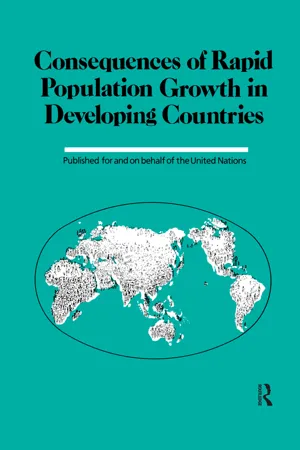
eBook - ePub
Consequences Of Rapid Population Growth In Developing Countries
- 390 pages
- English
- ePUB (mobile friendly)
- Available on iOS & Android
eBook - ePub
Consequences Of Rapid Population Growth In Developing Countries
About this book
First Published in 1991. This book holds the proceedings of the United Nations Institut national d' etudes demographiques Expert Group Meeting, New York, held on the 23-26 August 1988. Topics include the global trends in population growth, adaptation to rapid population growth, aspects and normative problems.
Frequently asked questions
Yes, you can cancel anytime from the Subscription tab in your account settings on the Perlego website. Your subscription will stay active until the end of your current billing period. Learn how to cancel your subscription.
At the moment all of our mobile-responsive ePub books are available to download via the app. Most of our PDFs are also available to download and we're working on making the final remaining ones downloadable now. Learn more here.
Perlego offers two plans: Essential and Complete
- Essential is ideal for learners and professionals who enjoy exploring a wide range of subjects. Access the Essential Library with 800,000+ trusted titles and best-sellers across business, personal growth, and the humanities. Includes unlimited reading time and Standard Read Aloud voice.
- Complete: Perfect for advanced learners and researchers needing full, unrestricted access. Unlock 1.4M+ books across hundreds of subjects, including academic and specialized titles. The Complete Plan also includes advanced features like Premium Read Aloud and Research Assistant.
We are an online textbook subscription service, where you can get access to an entire online library for less than the price of a single book per month. With over 1 million books across 1000+ topics, we’ve got you covered! Learn more here.
Look out for the read-aloud symbol on your next book to see if you can listen to it. The read-aloud tool reads text aloud for you, highlighting the text as it is being read. You can pause it, speed it up and slow it down. Learn more here.
Yes! You can use the Perlego app on both iOS or Android devices to read anytime, anywhere — even offline. Perfect for commutes or when you’re on the go.
Please note we cannot support devices running on iOS 13 and Android 7 or earlier. Learn more about using the app.
Please note we cannot support devices running on iOS 13 and Android 7 or earlier. Learn more about using the app.
Yes, you can access Consequences Of Rapid Population Growth In Developing Countries by Institut National d'etudes Demographiques in PDF and/or ePUB format, as well as other popular books in Politics & International Relations & Forecasting. We have over one million books available in our catalogue for you to explore.
Information
PART ONE
Introduction
Annex I
AGENDA
1. Opening of the meeting
2. Adoption of the agenda
3. Overview
(a) Population growth and structure in the less developed regions of the world according to the 1988 United Nations assessment
(b) Rapid population growth: a historical perspective
(c) Rapid population growth and socio-economic development in socialist developing countries
4. Economic consequences of rapid population growth
(a) Estimating the relationship between population growth and aggregate economic growth in LDC’s: methodological problems
(b) The world distribution of income: evolution over the recent period and effects of population growth
(c) Relations economiques internationales et croissance démographique rapide des economies dependantes
5. Effects of rapid population growth on resources for development
(a) Rapid population growth, the quality of health, and the quality of health care in developing countries
(b) Population growth and common property resources: micro-level evidence from India
(c) Rapid population growth and environmental stress
6. Rapid population growth, rural-urban migration and urbanization
(a) Rapid population growth, migration and development in the African context
(b) Urban population growth, employment and poverty in developing countries: a conceptual framework for policy analysis
7. Rapid population growth as a cause of family and institutional change
(a) Micro-simulation as a tool in exploring social and demographic interrelationships with an example from China, 1850–2200 or how tradition is achieved by modernity
(b) Rapid population growth and technical and institutional change
8. Rapid population growth and development planning
(a) Rapid population growth and economic development in Latin America
(b) Population growth and regional development planning in China
(c) Evaluating externalities to child-bearing in developing countries: the case of India
9. The consequences of rapid population growth as a basis for policy Panel discussion on the foundations of population growth policy
10. Closing of the meeting
Annex II
LIST OF DOCUMENTS
Symbol | Agenda item | Title/Author |
IESA/P/AC.26/1 | Provisional agenda | |
IESA/P/AC.26/2 | 3 | Population growth and structure in the less developed regions of the world according to the 1988 United Nations Assessment (United Nations Secretariat) |
IESA/P/AC.26/3 | 3 | A historical perspective on the economic consequences of rapid population growth (David Weir) |
IESA/P/AC.26/4 | 3 | Rapid population growth and socio-economic development in socialist developing countries (Zdenek Pavlik) |
IESA/P/AC.26/5 | 4 | Estimating the relationship between population growth and aggregate economic growth in LDC’s: methodological problems (Didier Blanchet) |
IESA/P/AC.26/6 | 4 | The world distribution of income: evolution over the recent period and effects of population growth (A. Berry, F. Bourguignon and C. Morrisson) |
IESA/P/AC.26/7 | 4 | International economic relations and rapid demographic growth in dependent countries (Jean Coussy) |
IESA/P/AC.26/8 | 5 | Rapid population growth, the quality of health, and the qualit... |
Table of contents
- Cover
- Half Title
- Title Page
- Copyright Page
- Table of Contents
- Preface
- Part One. Introduction
- Part Two. Global trends in population growth and economic growth
- Part Three. Adaptation to rapid population growth
- Part Four. Some specific aspects of rapid population growth
- Part Five. Normative problems
- Part Six. Conclusions
- Contributors